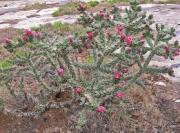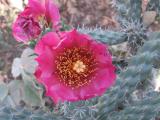Species features
Coral cactus, boxing glove cactus (Cylindropuntia fulgida var. mamillata)
| | |
Erect shrub up to 0.4-0.8 metres tall. Deciduous leaves. Rarely flowers/fruits.
Pads or segments: green-grey green. Often distorted, with a corrugated (tuberculate) surface, 10-22 centimetres long, two to 4.5 centimetres diameter. Often numerous, easily detached small segments.
Flowers: deep red.
Fruit: inverse cone or oval shaped. Grey-green. Forms long chains. Usually sterile.
Spines: four to 15 spines, 0.7-2 centimetres long, often shorter. Cream to brown (colour variable). White to tan sheath.
Impact
Modelling indicates that coral cactus would cost Western Australia $3.1 million each year if it is not managed and $1.7 million if it is managed.
Cook, D. 2014. Agricultural Resource Risk Management. Strategic Report. Impact Assessments for Declared Plants in Western Australia. July 2014. DAFWA.
Devil’s rope, rope pear (Cylindropuntia imbricata)

Branched shrub or small tree one to three metres tall. Often with short trunks. Deciduous leaves.
Pads or segments: dull grey-green. 15-40 centimetres long, 3.5 to five centimetres diameter. Large, widely spaced tubercles give a woven, rope like appearance.
Flowers: dark pink, magenta.
Fruit: fleshy, egg shaped, to four centimetres long. Greenish-yellow when ripe (can form chains).
Spines: two to 12 spines, 0.8 to three centimetres long. Trunks often covered in spines. Off white-cream. Off white-cream sheath attached.
Impact
Modelling indicates that devil's rope would cost Western Australia $3.5 million each year if it is not managed and $3.0 million if it is managed.
Cook, D. 2014. Agricultural Resource Risk Management. Strategic Report. Impact Assessments for Declared Plants in Western Australia. July 2014. DAFWA.
Klein's cholla (Cylindropuntia kleiniae)
| |
Straggly shrub to 0.5-2.5 metres tall. Large plants form a trunk. Deciduous leaves. 0.6-1.2 centimetres diameter.
Pads or segments: light grey-green. six to 26 centimetres long, 0.6-1.2 centimetres diameter.
Flowers: pink-red.
Fruit: egg or cylinder shaped.
Spines: one to four spines, 2-4.5 centimetres long. White to brown. Tan sheath firmly attached.
Pencil cactus (Cylindropuntia leptocaulis)
| | |
Appearance
Spreading shrub 0.4-1.8 metres tall. Deciduous leaves.
Pads or segments: green-grey green. Very slender, two to eight centimetres long, 0.3-0.5 centimetres diameter.
Flowers: pale to greenish yellow.
Fruit: fleshy, egg shaped.
Spines: zero to four spines, 0.5-1.5 centimetres long. Cream to pale yellow.
Agricultural and economic impact
A threat to rangelands in particular and known to impale cattle within its native range; also an environmental threat.
Jumping cholla (Cylindropuntia prolifera)
| | |
Appearance
Low shrub 0.4 to one metre tall. Deciduous leaves.
Pads or segments: greenish grey. 4-15 centimetres long, four to five centimetres diameter. Easily detached. Prominent tubercles.
Flowers: rose to magenta.
Fruit: top shaped, two to five centimetres long. Green. Can form chains. Usually sterile.
Spines: seven to 11 spines, one to two centimetres long. Light to dark brown, interlacing. White to tan sheath firmly attached.
Agricultural and economic impact
A serious threat to rangelands in particular as it can invade large areas and impale livestock and workers; also an environmental threat
Hudson pear (white-spined) (Cylindropuntia rosea)
| | |
Low, spreading shrub, 0.5 to one metre tall. Up to three metres wide. Old plants can develop trunks, but not commonly seen. Deciduous leaves.
Pads or segments: grey-pale green. 4.5-26 centimetres long, 1.5-3.5 centimetres diameter. Easily detached. Prominent tubercles.
Flowers: pink-red.
Fruit: oblong to egg shaped, to three centimetres long. Green-yellow green. Sterile hybrid.
Spines: seven to 14 spines, one to four centimetres long. White to light brown. White sheath loosely attached.
Impact
Modelling indicates that Hudson pear would cost Western Australia $3.5 million each year if it is not managed and $3.3 million if it is managed.
Cook, D. 2014. Agricultural Resource Risk Management. Strategic Report. Impact Assessments for Declared Plants in Western Australia. July 2014. DAFWA.
Snake cactus (Cylindropuntia spinosior)
| |
|
Appearance
Erect shrub to 1m tall. Often forming patches several metres wide. Similar to C. prolifera, but different spine and fruit colour. Deciduous leaves.
Pads or segments: mid grey-green. 10-24 centimetres long, 1.5 to three centimetres diameter. Firmly attached. Prominent tubercles.
Flowers: rose-purple.
Fruit: fleshy, cylindrical, to four centimetres long. Yellow, sometimes green.
Spines: six to 24 spines, 0.8-1.5 centimetres long, interlacing. White to grey. White sheath firmly attached.
Agricultural and economic impact
A serious threat to rangelands in particular as it can invade large areas and impale livestock and workers; also an environmental threat.
Hudson pear (brown-spined) (Cylindropuntia tunicata)
| | |
Low, densely branched shrub 0.3 to 0.6 metres tall. Deciduous leaves.
Pads or segments: pale grey-green. 10-20 centimetres long, 1.5 to three centimetres diameter. Easily detached. Prominent tubercles.
Flowers: yellowish-brown.
Fruit: club to top shaped. Greenish-yellowish to red. Spineless. Usually sterile.
Spines: four to seven spines, three to seven centimetres long. Red-brown to pale brown. Brownish sheath loosely attached.
Declared pest category
The Western Australian Organism List (WAOL) contains information on the area(s) in which this pest is declared and the control and keeping categories to which it has been assigned in Western Australia (WA). Search for Opuntia cacti in the WAOL by using the scientific name Opuntia.
Requirements for land owners/occupiers and other persons
Requirements for land owners/occupiers and other persons if this pest is found can be sourced through the declared plant requirements link.
Search > detect > report
| MyPestGuide™ Reporter | Pest and Disease Information Service (PaDIS) |
Control methods
Report the presence of this organism if it's legal status is prohibited before undertaking a control measure. Control methods for these declared plants can be found through the opuntioid cacti control link.
Further Information
For more information on cacti, download the Opuntioid cacti best practice control manual.

